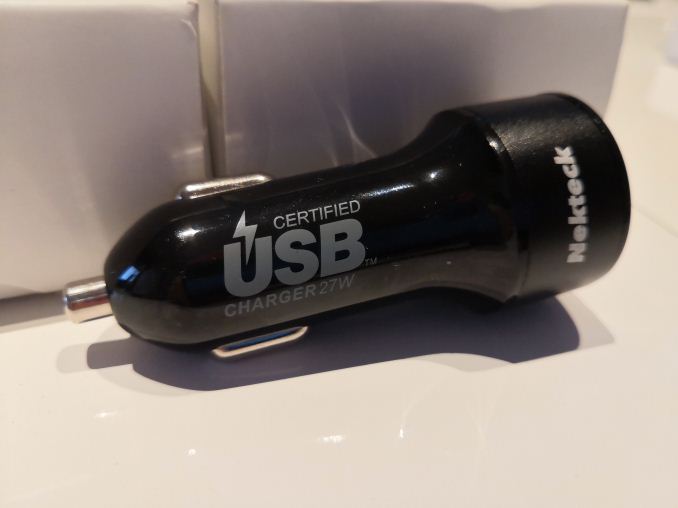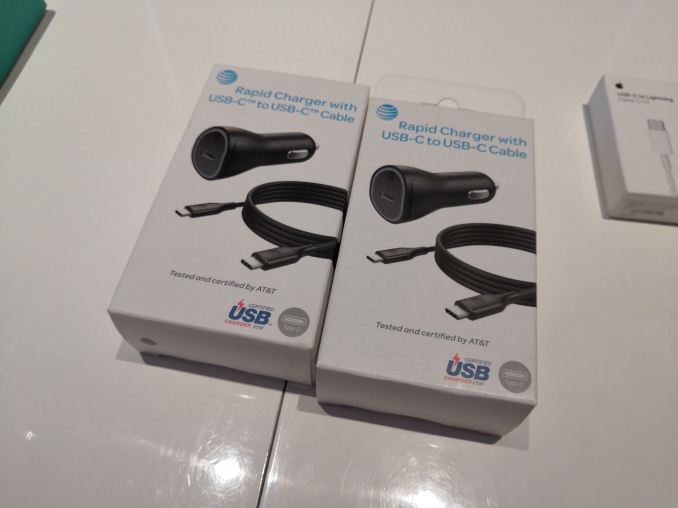USB-IF and Fast Charging: New Standard Logo with Wattage Listed
by Ian Cutress on June 13, 2018 12:00 PM EST- Posted in
- SoCs
- Systems
- charging
- Trade Shows
- USB-IF
- USB
- Computex 2018
- Fast Charging

When discussing industry standards, the sexy ones are involved around performance: if you can breathe PCIe 4.0 or PCIe 5.0 into a sentence, people start listening. One of the standards we actually deal with day in and day out though is around charging and USB charging. Not only do we have a series of standards in play for chargers over USB, but there are also a ton of companies that do their own thing in the mix outside of those standards. It can be, if we’re honest, a bit of a mess.
One of the new ways that the USB-IF is trying to fix this is with certified chargers and fast chargers. The new programs, previously announced in 2016 and back at CES 2018, are finally coming to fruition, and the USB-IF is showing off some of the new products released under the new standards. By using 11 certified test centers worldwide, the newest fast charging standards will enable wall chargers, car chargers, and other dedicated charging devices to carry a logo that states both that the unit adheres to the standards, but also the maximum power.
This listing of power is going to be a good thing. Users can know that if they need a 45W or a 65W charger, that what the logo says on the box is what the unit can handle. At the show we bumped into a company that already has chargers certified to 25W, 27W, 45W, and 65W. It was as clear as day which product was targeted for what sort of application.
Meanwhile the fast charging standard, which implements the USB Power Delivery Programmable Power Supply standard, allows for devices and chargers to do finer-grained voltage negotiation between USB-PD's major power classes (5V, 12V, etc). This allows a device to request the highest voltage it can take, as opposed to having to drop down to a lower power class entirely.
USB-IF also spoke about USB 3.2, with ASMedia at the show having a prototype 2x2 PHY on display. Despite the standard being finalized in September 2017, the first products and controllers are unlikely to be available until 2019 at the earliest.
| Want to keep up to date with all of our Computex 2018 Coverage? | ||||||
 Laptops |
 Hardware |
 Chips |
||||
| Follow AnandTech's breaking news here! | ||||||












28 Comments
View All Comments
ZeDestructor - Wednesday, June 13, 2018 - link
UL has allowed out of spec cables and chargers in the past... so I'm not putting much faith there....I miss Benson Leung and Nathan K, who both gave up on cable testing cause non-compliant crap kept blowing up expensive equipment.
Honestly, we need a nice crowd-funded reviewer to test things we want tested...
Alexvrb - Wednesday, June 13, 2018 - link
Would be nifty if someone designed/built a cheaper torture test setup that could weed out the most dangerous/shoddy cables. Any survivors move on to fancier tests. Something like that.Impulses - Thursday, June 14, 2018 - link
The problem with that concept is you just end up checking that X charger/cable works sort of okay, not figuring out in what ways it can fail catastrophically... But anyone can do the former with a simple USB volt/amp meter.Impulses - Thursday, June 14, 2018 - link
Truth!peevee - Thursday, June 14, 2018 - link
What kind of people are on these committees? No understanding of concepts of simplicity at all.How hard would it be to specify just doubling of voltage, so all power supplies would be 5V (to maintain compatibility, of not, I would start from 3.3), 10V, 20V, 40V, 80V (close to highest you can grab with wet hands and still let go), and all cables and other elements required to safely handle 3A without overheating even at 50C ambient? And supplies providing higher voltage required to support lower voltages too.
saratoga4 - Saturday, June 16, 2018 - link
>How hard would it be to specify just doubling of voltageSince most devices use standard power supply voltages like 5, 12, 15 .. etc. it would be quite hard. Very few devices would support anything but these voltages.
>What kind of people are on these committees? No understanding of concepts of simplicity at all.
Says the guys suggesting that all USB devices require custom power supplies.
DanNeely - Sunday, June 17, 2018 - link
Real world standards don't develop in a vacuum.We started with 5V 20 years ago because it was one of the standard PC power supply and small electronic operating voltages.
For 3.0 12V was added because it was the higher standard PC voltage and was used by a lot of existing power bricks. That got them theoretical ease of implementation on desktops, and free compatibility with lots of existing devices that would theoretically only need a new power socket to switch over to the new standard. 20V was the other voltage added because it was about the same as what many current laptop chargers used (19V) and could make an even round number while being within the output of most mass market laptop chargers. Also IIRC there was enough overlap in the tolerances of what the laptop side power circuitry could take that they would only need to change the plug to go from a legacy 19V @ 5A 95W supply to a 20V @ 5A 100W one.
9V and 14V both in in 3.1 in acknowledgement of the fact that numerous existing fast charge systems already used those to voltages. 12V was optionalized at the same time because it was too close to 14V to make any significant differentiation and hadn't been used enough yet for deprecating it to be an issue.
Significantly higher voltages run into the problem that you end up moving more and more of the PSU functionality from the charger to the device the larger the voltage drop its DC-DC converters have to do. In desktop systems the savings from resistive losses might be enough to justify a higher primary DC voltage, but the near total stagnation in desktop tech standards means that other than OEM only non-ATX designs there's no chance of it happening. In race to the thinnest laptop design anything that'd require a larger component to support is a no-go, so higher voltages are right out.
tommo1982 - Saturday, June 16, 2018 - link
I don't understand why the standards include wattage. All of the chargers sold have amperage written on the package and supported voltage/amperage on the back if it has Quick Charge. It's going to add more to confusion. Most of the customers understand that higher amperage equals faster charge, are they supposed to calculate supported amperage by a single glance?